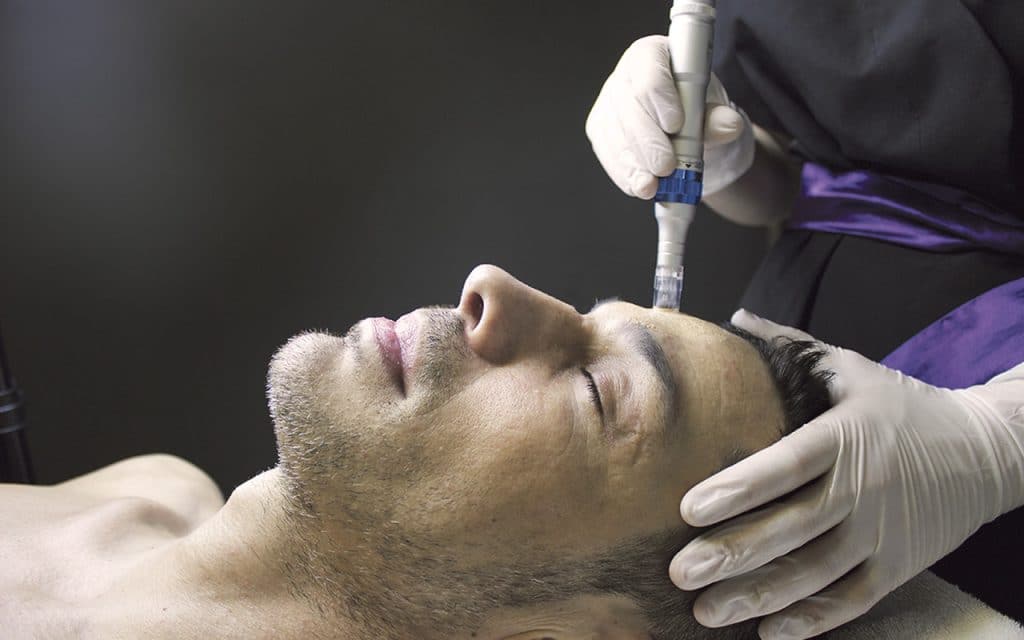In the past, a wrinkle-free face was considered a universal marker of youth. However, today’s beauty ideal has evolved. There is a noticeable shift towards the pursuit of a more youthful, dewy, and radiant complexion rather than a perfectly taut, wrinkle-free face. This change can be attributed to the increasing emphasis on ‘skin health’ over ‘anti-aging’. Modern beauty influencers and celebrities like Beyoncé, Gigi Hadid, and Rihanna have championed the glow-over-static look and, in the world of aesthetic medicine, the rise of non-invasive aesthetic treatments, away from injectables, has played a key role in this shift. Devices that focus on improving skin tone, texture, and elasticity – such as microneedling, IPL (Intense Pulsed Light), and fractional non-ablative lasers – offer patients the ability to maintain a fresh appearance without turning to more dramatic measures like facelifts or heavy filler use. Let’s take a look at some of these devices.

Microneedling: The collagen-boosting wonder
Microneedling is one of the most popular treatments for rejuvenating skin. The procedure involves using tiny, sterilised needles that create microscopic punctures in the skin’s surface. These controlled injuries stimulate the body’s natural wound-healing process, leading to increased collagen and elastin production. The result? Tighter, firmer skin with fewer wrinkles and a more even tone.
The benefits of microneedling include booting collaging, improving skin texture and can be used to improve the appearance of scars. There is minimal downtime compared to other treatments with around 24 hours of redness. Although minimal downtime is a benefit, it does mean to achieve optimal results you may need a number of sessions. Results take time.
IPL (Intense Pulsed Light): The multi-tasking skin saviour
Intense Pulsed Light (IPL) is a versatile treatment that uses light to target pigment, blood vessels, and other skin imperfections. Unlike lasers, which typically use a single wavelength of light, IPL emits a broad spectrum of light that can be absorbed by different skin issues like sun spots, redness, and pigmentation. IPL is particularly effective for treating sunspots, age spots, and melasma, giving the skin a more even tone. It can help reduce visible blood vessels and redness, particularly for those with rosacea. IPL can also encourage the production of collagen, improving skin texture and reducing the appearance of fine lines. The downtime really is minimal with IPL – some people even having it done on their lunch break.
While IPL is a great and versatile treatment, it has a few downsides. IPL can make your skin temporarily more sensitive to the sun, so diligent sun protection is required post-treatment. Because IPL targets pigment, those with darker skin tones may not see the same results and could be at a higher risk for pigmentation changes.
Fractional non-ablative lasers: precision with minimal downtime
Fractional non-ablative lasers are designed to treat the skin in a very targeted way, improving texture and tone without completely removing the top layer of skin. These lasers work by creating thousands of tiny, controlled ‘wounds’ in the skin while leaving the surrounding tissue intact, stimulating the body’s natural healing processes.
Fractional lasers target a wide range of skin concerns including fine lines, acne scars, sun damage, and melasma. Because the laser doesn’t fully remove the skin’s surface, the recovery time is shorter than with ablative lasers such as CO2. Redness and swelling may last a few days, but this is often manageable compared with 10-14 days of deep redness and swelling which goes with an ablative laser. The fractional approach allows for precise treatment, with fewer risks of side effects compared to traditional ablative lasers.
Like microneedling, fractional lasers often require several treatments to achieve optimal results. While the downtime is shorter than with other treatments, expect some discomfort and redness for a few days followed by some skin flaking and dryness for a few more days. Fractional laser treatments can be more expensive than other non-invasive options, making it less accessible for some.
One of the most appealing aspects of these non-invasive treatments is their versatility. They are not one-size-fits-all solutions but can be tailored to suit a variety of skin types, concerns, and personal goals.Whether you’re dealing with acne scars, pigmentation issues, fine lines, or simply want a healthy glow, there is a device designed to meet your needs.
Moreover, the appeal of these treatments extends beyond age and skin type. While younger individuals often seek out these devices for preventative reasons or to maintain their glow, older clients appreciate the ability to improve the texture and quality of their skin without undergoing surgery. The non-invasive nature of these treatments makes them accessible to a broad range of people looking for subtle yet noticeable improvements.
Finally, these treatments are popular because they require little downtime, allowing busy individuals to incorporate them into their lives without the inconvenience of lengthy recovery periods. The desire for subtle, natural enhancements that improve the overall health and appearance of the skin is universal, and these devices meet that demand effectively.



